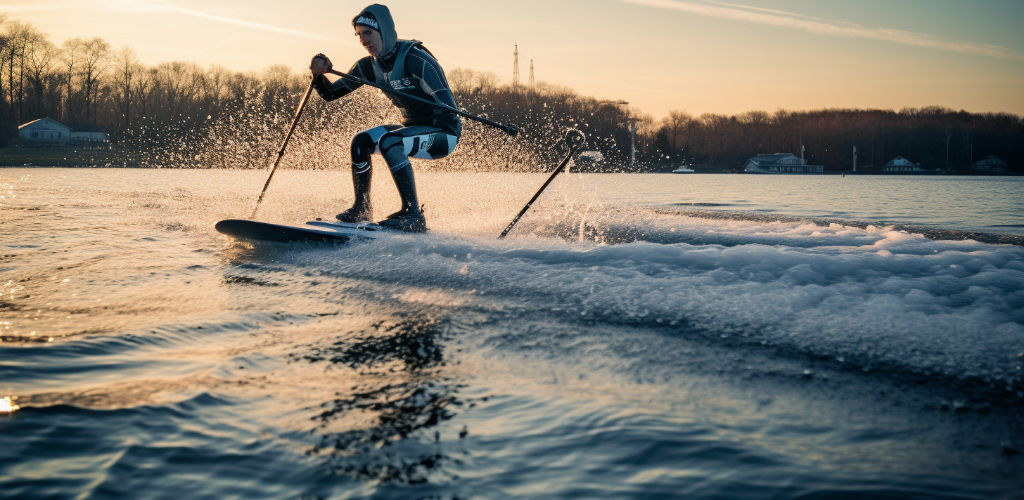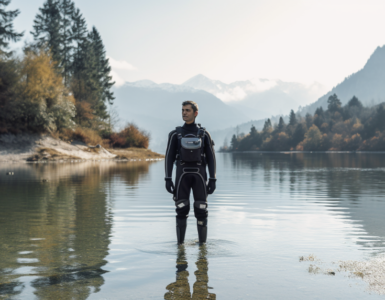Ever wondered what it takes to smoothly glide on water with a slalom ski? Well, for starters, a slalom ski is a type of water ski designed for a specific style of skiing where the skier navigates a course of buoys in a zigzag pattern. The thrill of water skiing is unparalleled, but like any sport, it requires learning the right techniques, especially when it comes to getting up on a slalom ski. Let’s dive into it!
There’s nothing quite like that exhilarating moment when you first get up on a slalom ski. It’s a blend of accomplishment, adrenaline, and pure joy. But to reach that moment, you need to know the ropes, quite literally!
The Importance of Proper Equipment
First and foremost, having the right equipment can make a significant difference in your water skiing experience. You’ll need a slalom ski that suits your body weight and skill level. Also, a sturdy ski rope and handle are crucial as they provide the connection between you and the boat. A life jacket is a non-negotiable safety item, and a boat with a capable driver is, of course, vital. Simple, right?
But remember, choosing the right equipment is just the first step. How you use them is what truly matters.
Safety Precautions
No sport is without risks, and slalom skiing is no exception. It’s imperative to take safety precautions seriously. A helmet can protect you from potential injuries, and a life jacket is a must for staying afloat. But safety doesn’t stop at gear.
It’s essential to have a spotter in the boat. Their role is to keep an eye on you while you’re skiing and communicate with the driver. So, are you ready to take the plunge with the right gear and a safety-first mindset?
Understanding the Basics of Slalom Skiing
Before we dive into the art of getting up on a slalom ski, it’s crucial to grasp the fundamentals of this exhilarating water sport. Slalom skiing may seem complex at first, but when broken down into its key components – body position, balance, and understanding water conditions – it becomes a much more approachable challenge.
Proper Body Position
What does the correct body position for slalom skiing look like? Imagine sitting in the water with your feet forward, knees bent, and arms straight. Sounds simple, right? But, it’s not as easy as it sounds! The key here is to maintain this position while the boat pulls you up and out of the water. It’s a bit like holding a squat at the gym – your muscles will be working hard!
Maintaining Balance
So, you’ve got the body position down, but what about balance? This is where the real fun starts. When you’re getting up on a slalom ski, it’s important to understand how to shift your body weight properly. Think about it: if you lean too far back, you’ll end up in the water. Lean too far forward, and you’ll faceplant. The key is to find that sweet spot where your weight is evenly distributed, allowing you to glide smoothly over the water’s surface. Sounds exciting, doesn’t it?
Reading Water Conditions
Now, let’s talk about water conditions. Just as a surfer reads the waves, a slalom skier must understand the water’s conditions. Are the waves choppy or calm? Is the wind strong or mild? These factors can greatly affect your skiing experience and require different techniques and adjustments. Remember, water conditions can change rapidly, so it’s essential to stay alert and adapt your techniques accordingly.
Preparing to Get Up
Are you ready to get up on a slalom ski? Not so fast! There are a few things you need to do before you attempt to rise out of the water. This includes securing the ski rope, positioning yourself correctly in the water, and signaling to the boat driver. These preparatory steps are crucial for a successful and safe slalom skiing experience. So, are you ready to take the plunge?
Step-By-Step Guide to Getting Up on a Slalom Ski
Getting up on a slalom ski may seem like a daunting task, but with the right technique, it can be a breeze. Let’s break down the process into simple, easy-to-follow steps.
- Position yourself in the water: Start by sitting in the water with your slalom ski on. Your knees should be bent towards your chest, and your arms should be straight, gripping the handle of the ski rope.
- Signal to the boat driver: Once you are in position, give a signal to the boat driver. This is usually a thumbs up. Make sure the driver can clearly see the signal.
- Start slow: The boat should start moving slowly. As the boat pulls you forward, let the water push the ski up. Don’t try to stand up too quickly – this is a common mistake.
- Stand up gradually: As the boat picks up speed, allow your body to rise gradually with the ski. Keep your arms straight and your body leaning back slightly.
- Maintain your balance: Once you’re up, it’s all about balance. Keep your knees slightly bent, your arms straight, and your body leaning back. And remember, always look straight ahead, not at your ski.
Common Mistakes and How to Avoid Them
As beginners, we are prone to making some common mistakes while learning a new skill. Let’s look at some that you might encounter while getting up on a slalom ski and explore ways to avoid them:
Mistake 1 – Trying to stand up too quickly: This is one of the most common mistakes. Remember, the water and the boat’s pull will naturally bring you and the ski up. Be patient, and let it happen.
Mistake 2 – Looking down at the ski: It’s tempting to look at the ski, but this can throw off your balance. Instead, keep your gaze straight ahead.
Mistake 3 – Not leaning back enough: Leaning forward too much can make you lose balance and fall. Instead, lean back slightly and maintain a strong core to keep your balance.
Mistake 4 – Bent arms: Keeping your arms straight is crucial for maintaining balance. Bent arms can cause you to pull yourself towards the handle, leading to a fall.
Practicing and Improving Your Skills
Now that you’ve got the basics down, it’s time to consider the next steps. Practice, as they say, makes perfect. And in the world of slalom skiing, this couldn’t be more true. But how exactly should you go about practicing? And what specific areas should you focus on?
Firstly, consistency is key. Make sure you get out on the water regularly. This doesn’t mean you have to ski every day, but try to make it a regular activity. The more you practice, the more your body will adapt to the movement and balance required.
Secondly, don’t be afraid to push yourself. Try to ski in different water conditions and at different speeds. This will not only test your balance and technique but will also make you a more versatile skier. Remember, always prioritize safety, especially when trying new challenges.
Conquering More Advanced Slalom Skiing Techniques
Once you’ve mastered the art of getting up on a slalom ski and have spent some time honing your skills, you might find yourself craving a new challenge. That’s where advanced techniques come into play. Let’s take a look at some of these techniques and how you can start to incorporate them into your skiing.
| Technique | Description | Tips to Master |
|---|---|---|
| One-handed skiing | Skiing with one hand on the handle, freeing the other hand. | Start with short periods of one-handed skiing and gradually increase the time as your confidence grows. |
| Crossing the wake | Jumping over the boat’s wake and skiing on the other side. | Start by crossing at a slow speed and low wake, gradually increasing both as you get comfortable. |
| Slalom course | Skiing around a set course of buoys in the water. | Start with a simple course and gradually make it more complex as your skills improve. |
Wrapping Up
So there you have it, your comprehensive guide to getting up on a slalom ski, practicing your skills, and even taking on some advanced techniques. Remember, every expert was once a beginner. With patience, practice, and a lot of enthusiasm, you’ll be cutting through the water like a pro in no time.
Slalom skiing is about more than just technique, it’s about the thrill of the ride, the joy of overcoming challenges, and the satisfaction of continuous improvement. So, what are you waiting for? Get out there and enjoy the ride!




